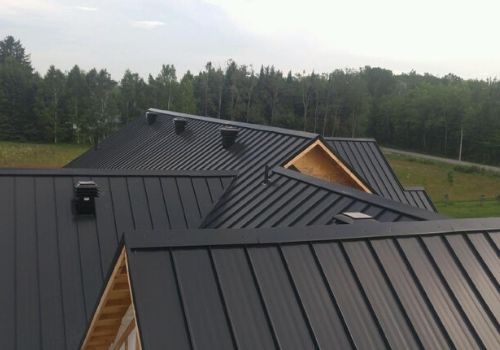When it comes to your home, the roofs play a pivotal and valuable role. They are more visible and have to endure harsher treatments from the elements.
Take it or leave it; your roof also contributes to your house’s heat loss or gain. If you would love to save energy and maintain a ‘green’ lifestyle, then the rooftop is where you should start.
When building a new roof or remodeling an existing one, it is best to choose a durable, energy saving and highly sustainable roofing material.
What Makes a Roofing Material Sustainable?
Sustainable roofing material can be determined based on the raw materials involved in the production. Sustainable roofing materials can be produced without permanently affecting or depleting the earth’s natural reserves. They are eco-friendly, green, and made with easy-to-source materials. Consequently, materials produced from fuel fossils or chemicals are not considered sustainable roofing materials.
No roofing material is truly sustainable, but some are more environmentally friendly than others. Here are 5 of the most sustainable roofing materials to consider.
The Most Sustainable Roofing Materials
- Wood Shingle
Wood as a biodegradable material is very easy to dispose of when not needed anymore. These are also called “sustainable wood shakes” and are considered one of the most sustainable building materials. They can also be found almost anywhere and have an aesthetic and luxurious appeal. Because of the insulating qualities of wood, this roofing is generally more energy efficient. The downside to using wood roofing is that they are more expensive, flammable, and not as enduring as other roofing materials. They require periodic maintenance and will last for as long as 25 years with proper maintenance.
- Slate
Slate is a natural material that has been used for roof production for more than a thousand years. They are built to last and are highly durable. A slate roof will, in most cases, outlive the house it was initially built on. They are also very beautiful and can be produced in varying thicknesses and colors. Slate roofs are water and fireproof and suitable for cooling the house during summer. However, they are expensive, heavy, and require highly technical installation. A slate roof can last for up to 100 years in ideal conditions.
- Metal
Although they rank low on the eco-friendly scale, metal roofs are energy efficient, affordable, and can weather extreme conditions. Most metal roofs are made from materials that do not need serious maintenance and can be easily recycled. Because of their resilient nature, they offer the best protection from the harshness of the elements and are adequately insulated. However, it is very uncommon to repair a metal roof; if damage occurs, a complete roof replacement might be the only solution. They are also prone to corrosion and dents from hails and can be noisy during rainstorms. Metal roofing materials can last for up to 60 years.
- Clay Tiles
Also known as terracotta, clay tiles are extremely durable and heat resistant. They are not affected by changes in temperature and do not harbor moss or algae growth. Clay is a very sustainable material and is easily obtainable and recyclable. They can also be painted over or glazed to create aesthetic and intricate designs. Due to their heavy nature, a clay roof is best suited for a new house, as the old one might not be able to support the weight. Installing clay roofing is cost-efficient, as they have a life expectancy of over 100 years, thus making up for its costly nature. You can pay more now and save more in the future.
- Green or Living Roofs
These roofs are low-sloped roofs containing varying portions of vegetation, hence the name ‘Green roofing’. Green roofs absorb moisture, thus improving water drainage and indoor air quality. You can cover your roofs with plants, grass, flowers, and other forms of vegetation that appeal to you. They are natural, biodegradable, and ideal for both cool and hot weather. They provide extra insulation and will greatly reduce your energy consumption and costs. Installing a living roof requires specific structural support that can only be gotten from professional companies. They are also harder to maintain and are not allowed in all areas. You should check with your local building department before starting the installation process. These roofs generally last for about 40 years.
Tips for Choosing a Sustainable Roofing Material
- Recyclability: The world has become greener, and any roofing material that does not contain recycled content or can be easily recycled should be a no-no for you.
- Weight: while heavier materials may seem more durable, you should always make sure your building structure can support them.
- Maintenance: Pick roofing materials that are durable and do not require a lot of money and effort to maintain.
- Coating material: Water from roofs can find its way into drinking and aquatic life sources, so you should always choose roof materials that are non-toxic. Materials like copper and zinc can be especially dangerous.
- Longevity: Select materials that would last longer and would not require constant replacement.
- Reflectivity: Go for lighter-colored and more reflective roofing materials, as they are more energy efficient than others.
Roofing is a daunting task that should be performed by experienced and qualified professionals. There are a lot of sustainable roofing materials out there, and you should check each one carefully before choosing the one that best suits your needs. If you need additional knowledge about the best roofing materials or how to choose one, do not hesitate to speak to a roofing expert.
Your Go-to Local Roofing Service
Our experts have honed their skills through years of roofing experience in Nanaimo, BC, and its environs. They also have the right equipment and techniques to properly install your roofs and ensure they serve their purposes just right.
Contact The Roof Pro now to get a free quote.


